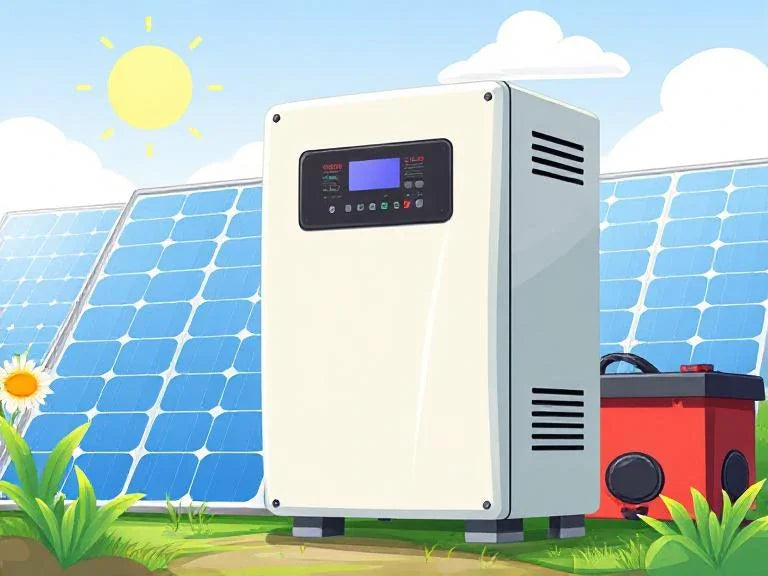
What Is an Inverter Split Phase?
If you’re exploring solar energy systems, you might have come across the term inverter split phase.
This type of inverter is designed to handle both 120V and 240V loads, making it perfect for homes and small businesses in the USA. But how does it actually work, and what makes it different from other inverters? Let’s find out.
How Does a Split-Phase Inverter Work?

A split-phase inverter converts DC (direct current) from solar panels or batteries into AC (alternating current) that powers your home. What makes it unique is its ability to deliver two AC output lines: one at 120V and another at 240V.
In a split-phase power system, these two outputs are 180 degrees out of phase, allowing the inverter to power both small household devices (like lights and TVs) and high-demand appliances (like dryers and air conditioners) efficiently.
This dual capability makes a dual-phase inverter a great choice for homes using both light and heavy electrical loads. It combines versatility with reliability, ensuring balanced power delivery throughout your system.
Benefits of Split-Phase Inverters
Choosing a split-phase inverter comes with several practical benefits that go beyond standard power conversion:
-
Supports 120/240V Loads: Powers both low and high-voltage appliances with one system.
-
Improved Energy Efficiency: Reduces conversion losses and ensures smoother AC power output.
-
Compatible with Solar Systems: Works seamlessly with solar inverters and off-grid inverters for renewable energy setups.
-
Battery Backup Ready: Can integrate with battery backup inverters for continuous power during outages.
-
Enhanced Safety and Stability: Balanced load distribution minimizes voltage drops and electrical risks.
These features make split-phase inverters a smart choice for both on-grid and off-grid systems.
Split-Phase vs. Single-Phase Inverter
While both single-phase and split-phase inverters convert DC to AC, they differ in power delivery and usage.
A single-phase inverter provides only one 120V AC output, suitable for smaller loads or limited applications. In contrast, a split-phase inverter delivers 120/240V output, making it ideal for homes and commercial setups with mixed power requirements.
So, if you want to power multiple types of equipment efficiently, a split-phase inverter is more flexible and future-ready.
Choosing the Right Split-Phase Inverter
When selecting the best inverter split phase, consider these important factors:
-
Power Capacity: Choose an inverter that matches your home’s total energy demand.
-
Battery Compatibility: Ensure it supports lithium battery or lead-acid battery systems.
-
MPPT Technology: Opt for inverters with Maximum Power Point Tracking (MPPT) to get maximum efficiency from your solar panels.
-
Hybrid Capability: If you want both grid connection and energy storage, consider a hybrid inverter with split-phase output.
-
Brand Reliability: Look for trusted solar technology brands offering reliable inverter chargers and robust warranties.
Selecting the right model ensures smooth operation, long life, and optimal energy conversion efficiency.
Applications of Split-Phase Inverters
Split-phase inverters are widely used across residential and light commercial setups due to their flexibility. Common applications include:
-
Homes with Solar Power Systems
-
Off-Grid Cabins or Remote Areas
-
Small Workshops or Farms
-
Emergency Battery Backup Systems
-
RV and Marine Setups
Their ability to provide stable AC power conversion makes them indispensable wherever dual-voltage power is required.
Split-Phase Inverter Installation Guide

Installing a split-phase inverter requires precision and expertise. Here’s a general step-by-step guide:
-
System Assessment: Evaluate your total energy load and inverter size requirements.
-
Mounting: Install the inverter on a flat, ventilated wall away from direct sunlight.
-
Wiring: Connect solar panels, batteries, and AC output lines as per manufacturer instructions.
-
Configuration: Set the system for 120/240V operation and test battery compatibility.
-
Inspection: Perform voltage checks and load tests to ensure safe, stable performance.
For safety and performance assurance, professional installation is highly recommended.
Conclusion
A split-phase inverter is an efficient and powerful solution for homes that require both 120V and 240V power. Whether you’re building an off-grid inverter system or upgrading your existing solar setup, split-phase technology ensures smoother energy flow and reliable performance.
To explore the best options for your home, visit Direct Solar Power and browse our Inverter Collection and Off-Grid Inverters today. Power your home smarter with split-phase innovation.
Frequently Asked Questions
1. What is the difference between a split-phase and a three-phase inverter?
A split-phase inverter delivers 120V and 240V outputs for home use, while a three-phase inverter is typically used in industrial or large commercial setups requiring higher voltage and power distribution.
2. Can a split-phase inverter be used with solar panels?
Yes, a split-phase inverter works perfectly with solar panels. It converts solar DC energy into 120/240V AC power for residential and small business applications.
3. What appliances can a split-phase inverter power?
It can run most household and heavy-duty appliances like refrigerators, washing machines, air conditioners, and water pumps.
4. Is professional installation required for a split-phase inverter?
Yes, because it involves handling both DC and AC connections, professional installation ensures safety, compliance, and peak performance.
5. What are the advantages of using a split-phase inverter?
It supports dual voltage outputs, provides efficient energy conversion, and offers better compatibility with battery and solar systems.

Leave a comment